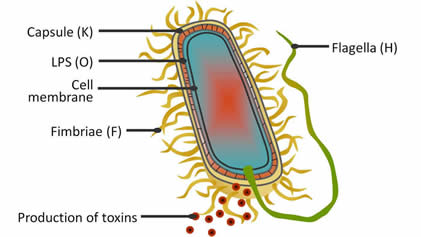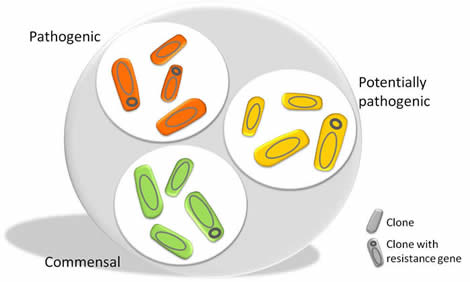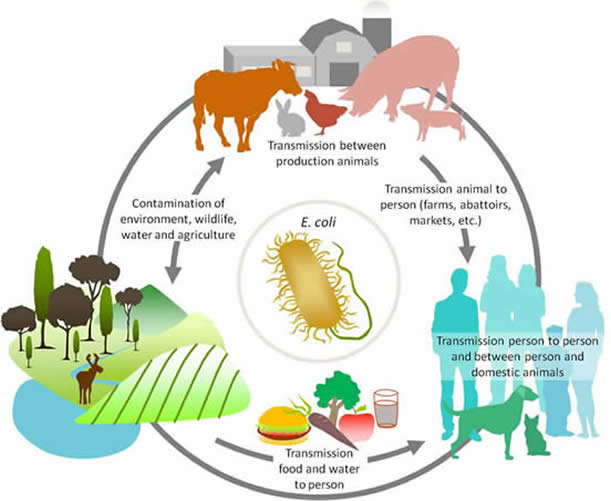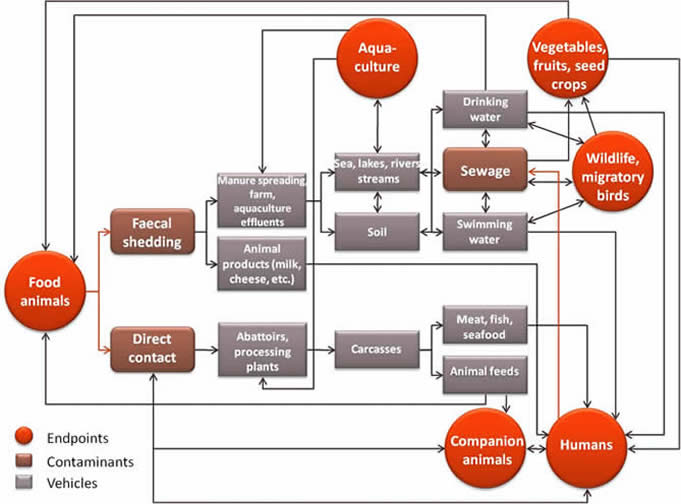Pathogenic E. coli
E. coli bacterium
E. coli is a Gram-negative bacterial rod which inhabits the intestinal microflora or ecosystem of most mammalian and bird species. E. coli is classified into 150 to 200 serotypes or serogroups based on somatic (O), capsular (K), fimbrial (F) and flagellar (H) antigens.

Sub-sets of clones differentiated by their ability to cause disease
Most E. coli are commensals, that is, they reside in the intestine but are not harmful for the host animal. Only a small proportion of strains are pathogenic, producing virulence factors permitting them to cause disease. Some E. coli possess virulence genes in combinations not known to be associated with disease, and may be considered as potentially pathogenic. All E. coli may carry genes for resistance to antimicrobial agents.

Sub-sets of pathogenic E. coli (pathotypes)
Pathogenic E. coli are classified into categories or pathotypes based on the production of broad classes of virulence factors and on the mechanisms by which they cause disease. Within each pathotype, strains are classified into virotypes or virulence gene profiles, based on the presence of combinations of virulence genes. Strains of a particular pathotype belong to a restricted number of serotypes or clones. Molecular genotyping or fingerprinting techniques such as pulse-field gel electrophoresis (PFGE) are being increasingly used as an adjunct or instead of serotyping, for the epidemiological monitoring of the E. coli in animals and their environment.

Ecology of pathogenic E. coli
E. coli bacteria are constantly being shed into the immediate environment of the animals via the faeces, and contaminate the pens, litter, and floor of animals being housed indoors and the soil for outdoor animals. They can persist for long periods, possibly more than 10 weeks, and be spread via the slurry and manure to fertilised fields and crops, and to ground and surface water. E. coli is transmitted to other animals via contaminated feed, handlers, and drinking water, and possibly farm to farm by vehicles such as transport trucks. Infection occurs by the oral route or via inhalation of contaminated dust in the case of birds. E. coli from animals may also be transmitted to humans «lien à la section Public Health» by direct contact, or ingestion of food or water contaminated following spread of manure, or ingestion of meat following contamination of carcasses at the slaughterhouse. Intestinal infections due to ETEC and oedema disease STEC in pigs are often contagious, the same strain being found in high numbers and in several sick pigs and from one batch to another. These strains are usually only shed for a few days after infection, probably due to the development of immunity. ExPEC infections do not behave like communicable diseases. Different strains are found in each individual animal, and mixed infections of more than one strain are often found in any one animal. The faecal microflora is a reservoir for extraintestinal infections such as mastitis, and urogenital tract infection. Similarly, EPEC are commonly found in the intestines and faeces of normal animals, but may cause disease in immunocompromised animals.
How E. coli fits into the “One health” paradigm

Ecology of E. coli

 Top of page
Top of page





